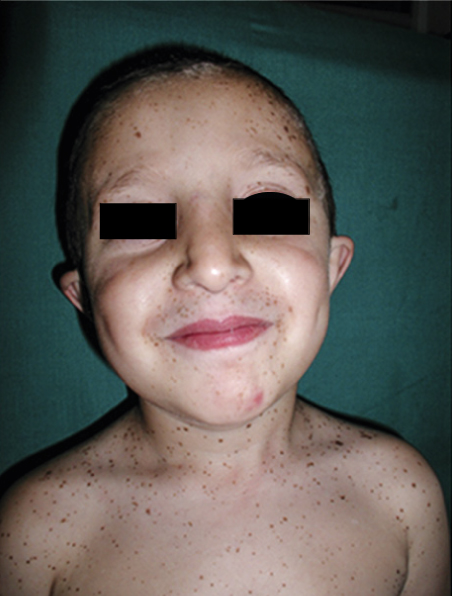Síndrome LEOPARD
DOI:
https://doi.org/10.29176/2590843X.62Palabras clave:
enfermedades cutáneas genéticas, cardiomiopatía hipertrófica, síndrome LEOPARDResumen
El síndrome LEOPARD es una genodermatosis esporádica o autosómica dominante de gran penetrancia y expresividad variable, poco frecuente, con pocos casos reportados en la literatura científica.
Su nombre es un acrónimo que, por sus siglas en inglés, resume las principales características del síndrome: L, lentiginosis; E, alteraciones electrocardiográficas; O, hipertelorismo ocular; P, estenosis de la arteria pulmonar; A, anormalidades genitourinarias; R, retraso del crecimiento, y D (deafness), sordera neurosensorial.
Se presenta un caso que ilustra algunas de las manifestaciones clásicas del síndrome LEOPARD, y se resalta la importancia del estudio, abordaje y seguimiento multidisciplinario.
Biografía del autor/a
María Angélica Macías, Hospital Simón Bolívar
Médica, dermatóloga pediatra, Hospital Simón Bolívar, Bogotá, D.C., Colombia
Ana María Téllez, Fundación Universitaria Sanitas
Médico dermatólogo, Fundación Universitaria Sanitas, Bogotá, D.C., Colombia
John Ballén, Fundación Universitaria Sanitas
Médico dermatólogo, Fundación Universitaria Sanitas, Bogotá, D.C., Colombia
Carolina Hernández, Universidad Militar Nueva Granada
Médica pediatra, Universidad Militar Nueva Granada, Bogotá, D.C., Colombia
Referencias bibliográficas
Kalev I, Muru K, Teek R, Zordania R, Reimand T, Köbas K, et al. LEOPARD syndrome with recurrent PTPN11 mutation Y279C and different cutaneous manifestations: Two case reports and a review of the literature. Eur J Pediatr. 2010;169:469-73. https://doi.org/10.1007/s00431-009-1058-1
Martínez-Quintana E, Rodríguez-González F. LEOPARD syndrome: Clinical features and gene mutations. Mol Syndr. 2012;3:145-57. https://doi.org/10.1159/000342251
Carcavilla A, Santomé JL, Pinto I, Sánchez-Pozo J, Guillén-Navarro E, Martín-Frías M, et al. LEOPARD Syndrome: A variant of Noonan syndrome strongly associated with hypertrophic cardiomyopathy. Rev Esp Cardiol. 2013;66:350-6. https://doi.org/10.1016/j.recesp.2012.09.017
Tartaglia M, Gelb BD, Zenker M. Noonan syndrome and clinically related disorders. Best Pr Res Endocrinol Metab. 2011;25:161-79. https://doi.org/10.1016/j.beem.2010.09.002
Rodríguez-Bujaldón A, Vásquez-Brayo C, JiménezPuya R, Galán-Gutiérrez M. LEOPARD syndrome: What are café noir spots? Pediatr Dermatol. 2008;25:444-8. https://doi.org/10.1111/j.1525-1470.2008.00734.x
Kato H, Yoshida R, Tsukamoto K, Suga H, Eto H, Higashino T, et al. Familial cases of atypical clinical features genetically diagnosed as LEOPARD syndrome (multiple lentigines syndrome). Int J Dermatol. 2010;49:1146-51. https://doi.org/10.1111/j.1365-4632.2010.04559.x
Digilio M, Sarkozy A, de Zorzi A, Pacileo G, Limongelli G, Mingarelli R. Leopard syndrome: Clinical diagnosis in the first year of life. Am J Med Genet A. 2006;140:740-6. https://doi.org/10.1002/ajmg.a.31156
Treadwell P. Systemic conditions in children associated with pigmentary changes. Clini Dermatol. 2015;33:362-7. https://doi.org/10.1016/j.clindermatol.2014.12.014
Banuls J, Álvarez-Chinchilla PJ, Lucas A, Poveda I,Encabo-Durán B, Niveiro M, et al. Clinical, pathological and dermoscopic characteristics of cutaneous lesions in LEOPARD syndrome. J Eur Acad Dermatology Venereol. 2018;32:e100-1. https://doi.org/10.1111/jdv.14573
Koller VM, Giovanna PD, Otero M, García S, Cabrera H. Síndrome LEOPARD a propósito de la mancha café negro. Arch Agent Dermatol. 2009;59:53-7.
Jurko T, Jurko A, Krsiakova J, Jurko A, Minarik M, Mestanik M. Importance of cardiovascular examination in patients with multiple lentigines: Two cases of LEOPARD syndrome with hypertrophic cardiomyopathy. Acta Clin Belgica Int J Clin Lab Med.2018;3286:1-4. https://doi.org/10.1080/17843286.2018.1467531
Martínez-Quintana E, Rodríguez-González F. RASopathies: From Noonan to LEOPARD Syndrome. Rev Esp Cardiol. 2013;66:756-7. https://doi.org/10.1016/j.recesp.2013.05.006
González-Rodríguez A, Lorente-Gual R. Current indications and new applications of intense pulsed light. Actas Dermosifiliogr. 2015;106:350-64. https://doi.org/10.1016/j.ad.2014.10.004
Kontoes PP, Vlachos SP, Marayiannis KV. Intense pulsed light for the treatment of lentigines in LEOPARD syndrome. Br J Plast Surg. 2003;56:607-10. https://doi.org/10.1016/S0007-1226(03)00218-2
Cómo citar
Descargas

Descargas
Publicado
Cómo citar
Número
Sección
Licencia

Esta obra está bajo una licencia internacional Creative Commons Atribución-NoComercial-CompartirIgual 4.0.

| Estadísticas de artículo | |
|---|---|
| Vistas de resúmenes | |
| Vistas de PDF | |
| Descargas de PDF | |
| Vistas de HTML | |
| Otras vistas | |






